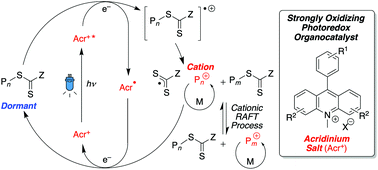Acridinium salts as photoredox organocatalysts for photomediated cationic RAFT and DT polymerizations of vinyl ethers†‡
Abstract
A series of acridinium salts with high excited-state oxidative power are employed as photoredox organocatalysts in conjunction with various thioesters, such as trithiocarbonate, dithiocarbamate, and xanthate, and thioacetals for photomediated cationic reversible addition–fragmentation chain-transfer (RAFT) and degenerative chain-transfer (DT) polymerizations of vinyl ethers under visible light. A combination of acridinium salts and trithiocarbonate or thioacetal induces relatively fast and controlled cationic polymerization of various alkyl vinyl ethers under blue, green, and white LEDs, where the photoexcited acridinium salts generate cationic species from the sulfur compounds via the mesolytic cleavage of carbon–sulfur bonds through the formation of radical cations. An acridinium salt with a higher excited-state oxidative power induces faster cationic polymerization. Temporal control of the polymerization is achievable by switching the light on and off, although the polymerization in the dark is not completely halted. The controlled nature of the polymerization further enables the synthesis of block copolymers of alkyl vinyl ethers via sequential monomer addition.

- This article is part of the themed collection: Synthetic Methodologies for Complex Macromolecular Structures


 Please wait while we load your content...
Please wait while we load your content...